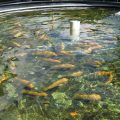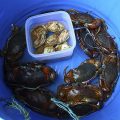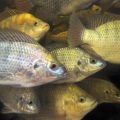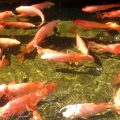Integrated pig-fish culture is not a new concept; it has been practiced for many years in most of Asia. Raising pigs and fish at the same time has several advantages:
· Fish farmers can produce fish without feeding and hauling manure to fertilize the pond.
· Pig-fish culture maximizes land use by integrating two farm enterprises in the same area.
· The fish pond serves as a sanitary disposal place for animal wastes.
· Backyard integrated pig-fish culture provides additional income and a cheap source of animal protein for the family.
ESTABLISHING THE SYSTEM
1. Pond Construction
Establish the pond near a water source. However, the site should be free from flooding. Inlet and outlet pipes should be installed and screened.
One pig can sufficiently fertilize a 100-150 sq m pond with. its manure. The water depth should be maintained at 60-100 cm. With this recommended pond area and water depth together with the right stocking density, problems of organic pollution are avoided.
A diversion canal can be constructed to channel excess manure into a compost pit or when manure loading needs to be stopped.
2. Location of the Pig Pen
The pig pen should be constructed over the dikes near the fish pond. Preferably, the floor should be made of concrete and should slope toward the pond. A pipe is necessary to convey the manure into the pond. An alternative design is to construct the pig pen over the pond. The floor is made of bamboo slats spaced just enough to allow manure to fall directly into the pond but not too wide for the feet of the pigs to slip into (thus, causing injuries). The pen should have a floor area of 1 m x 1.5 m for each pig.
3. Stocking
· Stock the pond with fingerlings once the pond is filled up with water. The recommended stocking rate are as follows:
Monoculture: Tilapia (Oreochromis niloticus) -2 fish/sq m (3-5 g eve wt)
Polyculture | :200 fish/100 sq m (3-5 g eve wt) |
85% Tilapia(170 fingerlings) | |
13% Common carp (Cyprinus carplo, 26 fingerlings) | |
2% Snake heads (Channa striata) and | |
Cat fish (Clarlas batrachus) – 4 fingerlings, 1-2 9 eve wt | |
Polyculture: | 200 fish/100 sq m (Vietnam and Thailand experience) |
50% Pangaslus micronemus (100 fingerlings, 10 g) | |
30% Tilapia (60 fingerlings, 3-5 g) | |
20% Kissing gourami (Hllostoma temminckl) – 40 fingerlings, 1-2g |
· Stock the pig pen with 8-10 kg or 1 1/2 month old weanlings.
· Fish and piglets can be stocked at the same time.
4. Feeding
Feed the pigs twice a day. Supplemental feeds such as ipil-ipil (Leucaena leucocephala) or kangkong (Ipomea aquatica) may be given.
5. Harvesting
· Harvest the fish after 4-5 months. Collect fingerlings for the next growing season; sell the surplus. Partial harvesting for family consumption can also be done as needed.
· Sell the pig after 4-5 months..
· Scrape out the organic waste or mud on the pond floor and use as fertilizer for the vegetable crop.
LIMITATIONS
· High cost of inputs (feeds and weanlings)
· Consumers may be reluctant to eat fish produced in manure-loaded ponds, creating potential marketing problems.
· Farmers want their animals close to their homes (because of theft problems, and this may not be always possible.
POSSIBLE SOLUTIONS TO OVERCOME SOME OF THE LIMITATIONS
1. Raise crossbred/native pigs to reduce feed cost.
2. To make the harvested fish from manure-loaded ponds more acceptable to consumers, remove the socalled “muddy” or off- flavor taste by:
· Stop loading manure to the pond a few days before harvesting fish.
· Transfer harvested fish to a net enclosure installed in a clear pond at least 4-6 hours prior to selling or eating them.
Cost and return of the backyard integrated pig-fish culture (five months)
COSTS | |
Pig component | |
Weanling | P 1,000.00 |
Commercial feeds | 1,246.60 |
Medicines | 34 00 |
Rice bran (25 kg) | 87.50 |
Labor | 300.00 |
Pig pen maintenance | 50.00 |
Fish component | |
Pond maintenance | 250.00 |
Fingerlings | 40.00 |
P 3,008.10 | |
Income Output | |
Pig (1 head) | P 3,050 00 |
Fish (27.5 kg at 40/kg) | 1,100.00 |
Fish fingerlings (1 ,100 at P.02/piece) | 220.00 |
P 4,370.00 | |
Balance | P 1,369.90 |
Capital Investments (Fixed items) | |
Pig pen (P500 at 6 years) | P 500.00 |
Pond construction | 200.00 |
Bucket | 80.00 |
P 780.00 |
Rate of return on investment = (1369.90 /780) x100 = 176%
Note:
* For P00 invested, the farmer gets P176.00
* Entire capital costs can be recovered in one production cycle and yet retain a surplus.
source: www.nzdl.org






